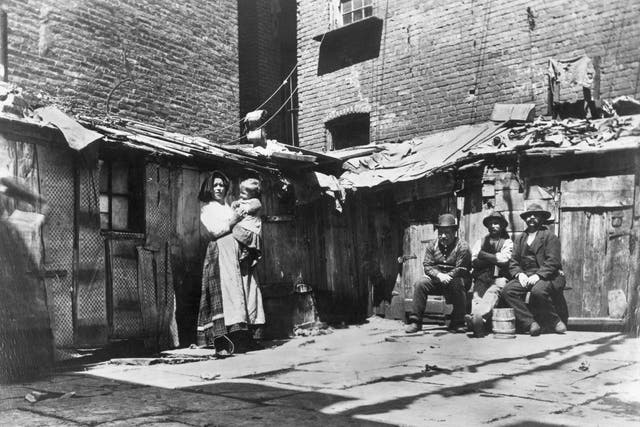

In the 19th century, more and more people began crowding into America’s cities, including thousands of newly arrived immigrants seeking a better life than the one they had left behind. In New York City–where the population roughly doubled every 20 years from 1800 to 1880–buildings that had once been single-family dwellings were increasingly divided into multiple living spaces to accommodate this growing population.
Known as tenements, these narrow, low-rise apartment buildings–many of them concentrated in the city’s Lower East Side neighborhood–were all too often cramped, poorly lit and lacked indoor plumbing and proper ventilation. By 1900, some 2.3 million people (a full two-thirds of New York City’s population) were living in tenement housing.
In the first half of the 19th century, many of the more affluent residents of New York’s Lower East Side neighborhood began to move further north, leaving their low-rise masonry row houses behind. At the same time, more and more immigrants began to flow into the city, many of them fleeing the Irish Potato Famine, or Great Hunger, in Ireland or revolution in Germany. Both of these groups of new arrivals concentrated themselves on the Lower East Side, moving into row houses that had been converted from single-family dwellings into multiple-apartment tenements, or into new tenement housing built specifically for that purpose.
1 / 10 : Jacob Riis/Bettman Archive/Getty ImagesThe existence of tenement legislation did not guarantee its enforcement, however, and conditions were little improved by 1889, when the Danish-born author and photographer Jacob Riis was researching the series of newspaper articles that would become his seminal book “How the Other Half Lives.”
Riis had experienced firsthand the hardship of immigrant life in New York City, and as a police reporter for newspapers, including The Evening Sun, he had gotten a unique view into the grimy, crime-infested world of the Lower East Side. Seeking to draw attention to the horrible conditions in which many urban Americans were living, Riis photographed what he saw in the tenements and used these vivid photos to accompany the text of “How the Other Half Lives,” published in 1890.
The hard facts included in Riis’ book–such as the fact that 12 adults slept in a room some 13 feet across, and that the infant death rate in the tenements was as high as 1 in 10–stunned many in America and around the world and led to a renewed call for reform.
Two major studies of tenements were completed in the 1890s, and in 1901 city officials passed the Tenement House Law, which effectively outlawed the construction of new tenements on 25-foot lots and mandated improved sanitary conditions, fire escapes and access to light. Under the new law–which in contrast to past legislation would actually be enforced–pre-existing tenement structures were updated, and more than 200,000 new apartments were built over the next 15 years, supervised by city authorities.
By the late 1920s, many tenements in Chicago had been demolished and replaced with large, privately subsidized apartment projects. The next decade saw the implementation of President Franklin D. Roosevelt’s New Deal, which would transform low-income housing in many American cities through programs including slum clearing and the building of public housing.
The first fully government-built public housing project opened in New York City in 1936. Called First Houses, it consisted of a number of rehabilitated pre-law tenements covering a partial block at Avenue A and East 3rd Street, an area that had been considered part of the Lower East Side.
Among the trendy restaurants, boutique hotels and bars that can be found in the neighborhood today, visitors can still get a glimpse into its past at the Lower East Side Tenement Museum, located at 97 Orchard Street.
Built in 1863, the building is an example of an “old-law” tenement (as defined by the Tenement House Act of 1867) and was home over the years for some 7,000 working class immigrants. Though the basement and the first floor have been renovated, the rest of the building looks much the same as it did in the 19th century, and has been designated a National Historic Site.
America The Story of Us is an epic 12-hour television event that tells the extraordinary story of how America was invented.